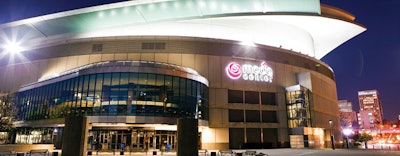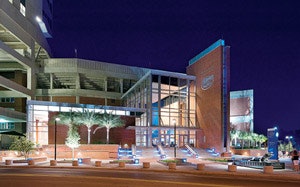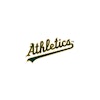
Home of the Portland Trail Blazers, the Moda Center became the first major league sports venue in the United States to achieve LEED gold certification in 2010 (it was called the Rose Garden at the time). But its sustainability record was well established by then.
According to a Sept. 4 National Sports Forum newsletter, since 2008 the Trail Blazers have diverted 90 percent of their waste from landfills; cut energy, water and gas consumption by more than 30 percent; and switched to 100 percent usage of compostable and local/organic food-related materials. They save more than 2.5 million kilowatt hours per year, purchasing what energy they need through 100 percent renewable sources. The measures, which the Trail Blazers expect to precipitate eventual LEED platinum certification, have not come cheap. Since 2008, the Trail Blazers have invested $643,000 into their sustainability practices, but that number is dwarfed by the team's operational savings of $3 million over that timespan. That equates to a 467 percent return on investment.
For sports facilities everywhere, it's never been easier being green.
The green sports movement, which began some 35 years ago, now benefits from rapidly improving building infrastructure technologies and a growing list of best practices based on proven operational successes. "This is a golden age of energy-efficiency enhancements at stadiums and arenas," says Allen Hershkowitz, senior scientist at the Natural Resources Defense Council for the past 25 years, and a leader from day one of the green sports movement. "This issue is now of greater interest at stadiums and arenas than ever."
 ROOM FOR IMPROVEMENT The LEED-platinum-certified Heavener Football Complex employs many — but not all — available green technologies. (Photos courtesy of the University of Florida)
ROOM FOR IMPROVEMENT The LEED-platinum-certified Heavener Football Complex employs many — but not all — available green technologies. (Photos courtesy of the University of Florida)
THE NEW COLLEGE TRY
The numbers posted in Portland should get any stadium or arena operator's attention, but it helps to have environmentally conscious leadership such as Paul Allen, who owns the Trail Blazers and their arena, according to Hershkowitz. "There's no question that financial benefits are the big driver, and that makes sense. It's a big driver in all businesses," he says. "In the case of colleges, and some professional owners, you would still see some work on this issue, because in my experiences there are a lot of environmentally oriented team owners and league commissioners. There are a lot of them who are really concerned about global warming and waste generation. When you get to run a team or league, you're typically a pretty bright person. These things are not being run by stupid people, and people who pay attention to the world know that there are issues that need to be addressed."
 Click to enlarge
Click to enlarge
Individual college campuses are presented with even more expansive sustainability opportunities. Since 2006, the University of Florida has seen no fewer than five athletics venues achieve LEED certification of silver or higher. Its "crown jewel," in the words of Brian Barton, director of facilities for UF athletics, is the Heavener Football Complex, which in 2008 became the first facility of any kind in the state and the first athletic facility in the country to achieve LEED platinum status.
Florida athletics venues incorporate such technologies as dual-flush toilets and low-flow plumbing fixtures, which have reduced interior water use by 40 percent. Native plants and efficient irrigation have reduced exterior water consumption by 50 percent, and all water used for irrigation has been reclaimed. Moreover, 100 percent of all wastewater is treated onsite.
The Heavener Complex's energy use has been reduced 25 percent by using occupancy sensors and other measures. And there's room for improvement. The university has yet to tap the power of the Florida sun, but solar energy is being considered, according to Barton. Likewise, UF has researched LED arena lighting, but has not yet tapped its energy-saving potential. Regardless, sustainability has become a permanent part of the athletic department's collective mindset. "It's part of everything we do now," Barton says. "It's a philosophy. It's what our campus is doing. It's what the world's doing. It's the right thing to do."
And Florida is just one campus example. The NRDC this year released a report on college sports sustainability, highlighting the efforts of 30 schools — from the zero-waste game day initiatives at Colorado and Ohio State to the wind turbines adjacent to the football stadium at North Texas. "This was the first time that we sought to build a dialogue on this topic around case studies that exist," says report author Alice Henly, who directs the NRDC's college work, launched last year. "This report is the first endeavor in the college sports market to collect success stories and begin to build some models for others to replicate."
EDUCATING FANS, OPERATORS
Henly admits that the level of sustainability engagement on campuses, and especially among students, surprised even her. "Students are seriously concerned about climate change," she says, pointing to a 2012 Princeton Review report that found 62 percent of incoming college students consider a school's sustainability commitment when deciding where to attend. "In response, colleges are turning their sports programs into part of the solution. Sports programs can't fix our urgent environmental problems by themselves. We know that. But by taking action, these athletics departments are bringing climate solutions to the mainstream.
"Millions of students and sports fans live and breathe college athletics. College sports fans are the largest sports fan base, and they are some of the most highly educated and affluent sectors of the American public, and they have a great opportunity to change the conversation around the environmental challenges that we face and broaden the dialogue around energy efficiency. That makes these greening efforts so powerful, and that is the difference between sustainability initiatives that have been under way on campuses for a couple decades and athletics greening efforts that can reach millions of college sports fans."
That is not to say that educational opportunities don't exist at every level. "The major benefit of sports is its ability to amplify the message to the marketplace so substantially, so widely, so powerfully, so non-politically," says Hershkowitz. "When you've got the Boston Red Sox and the San Francisco 49ers talking about environmental responsibility, that message is broadcast more visibly than if other large buildings or businesses embrace environmental messaging."
Fan engagement on the issue of sustainability is just one topic that Hershkowitz intends to cover in his Sports and Sustainability Certificate course, available next September through the San Francisco-based Presidio Business School. The course, taught by sports facility operators for sports facility operators, will cover such topics as water conservation, waste management and recycling, and sponsor relations in the green space. An entire day will be devoted to energy usage, according to Hershkowitz, who was recently appointed distinguished scholar in residence for sustainability in sports at the school. "The stadium and arena operators I've mentioned it to are very keen on it," he says. "There's great interest in this issue of reducing environmental impacts and also reducing costs through managing environmental impacts in the sports world."
 Click to enlarge
Click to enlarge
GETTING STARTED
For those operators who want to get greening right away, Hershkowitz recommends they conduct a comprehensive energy-efficiency audit of their facility. "If the venue has not done that in the past five years, it should do it, because technology has advanced considerably," he says.
And while fan transportation still has by far the biggest impact on a sports venue's carbon footprint, there are other factors more easily addressed. "Lighting offers the largest and quickest return in the short term," Hershkowitz says, with a nod toward rapidly advancing LED technology. "Everybody should be looking at their lighting."
There may be no quick fix to the global environmental issues at hand — if they can be fixed at all. But at no point in the 35-year-old green sports movement have sports venue operators had greater incentive — both ecological and economical — to try. "The environmental situation we have found ourselves in regarding global warming or biodiversity loss or the proliferation of waste is not the result of one or two big players. The situation we're in is because millions of businesses and billions of consumers have been making environmentally ignorant decisions for decades," Hershkowitz says. "So there is no one big thing that we're going to be able to do that's going to reverse our ecological problem. Even if all of sports eliminated all of its emissions, that would not solve global warming. The point I'm making is everybody has to do something. The same way that everybody contributed to the problem, now everybody has to contribute to the solution."

In 2013, the National Resources Defense Council released a report on college sports sustainability, highlighting the efforts of 30 schools. To access the full report, click here.
For sample NRDC guidelines for tracking the greening of your sports organization, click here.

































